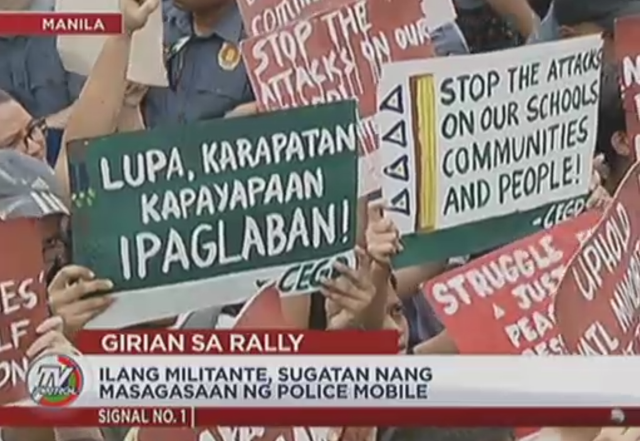US Embassy Protest: A Focus on Violence and Not Much Else

Screengrab from ABS-CBN News official Youtube account.
JEERS TO the Manila-based media for focusing on the sensational, overlooking important information in the reports on the Oct. 19 protest at the US Embassy that ended in the violent dispersal of the protesters. In general, the coverage paid more attention to the confrontation between police and protest groups, without telling the public what the protest was all about.
CMFR looked into the reports of primetime news programs 24 Oras (GMA-7), Aksyon (TV5), Network News (CNN Philippines), and TV Patrol (ABS-CBN 2) as well as the three broadsheets Philippine Daily Inquirer, Manila Bulletin and The Philippine Star from Oct. 19 to 23.
Indigenous peoples and other groups held a rally in front of the US Embassy in Manila in support of President Rodrigo Duterte’s declaration that he would pursue an independent foreign policy. The demonstration ended in a violent dispersal resulting in injuries to both the protesters and officers of the Philippine National Police (PNP).
The media, particularly television, showed graphic images of protesters being run over by a police van, as well as of policemen with shields and truncheons beating protesters.
Media reports before the actual rally identified these groups as Lumads and Moros from Mindanao and other indigenous peoples from the Cordillera, Central and Southern Luzon who had traveled to Manila to protest mining and militarization in their communities and to uphold their right to their ancestral lands. The reports on the incident, however, simply identified them as “militants,” the term usually used by the press to refer to left-wing groups. Some members of the latter groups–such as Bagong Alyansang Makabayan (Bayan) and Bayan Muna–were in the demonstration but from all indications were a minority.
The media also reported PNP deputy chief for operations Police Director Benjamin Magalong’s admission in an Oct. 20 press conference that there were lapses in the implementation of their own operational procedures –which media mentioned only in passing. Some knowledge of the 2013 Revised PNP Police Operational Procedures, particularly Rule 25 (Rallies and Demonstrations), could have helped the media include these lapses in police protocol mentioned by Magalong.
For example, Rule 25.3 states that civil disturbance management (CDM) contingents on the ground should be in the prescribed uniform without firearms. Some television footage did show a policeman carrying a small pistol which the former quickly hid under his uniform when he noticed he was being filmed. Media failed to mention, however, that police personnel assigned to demonstrations are prohibited from carrying any kind of firearm but may be equipped with batons or riot sticks (Rule 26.2-a Specific Guidelines). Other prohibitions could have been mentioned with footage showing police officers beating fleeing protesters and causing them unnecessary injury.
Rallies and demonstrations have long been part of Philippine history; such incidents are no longer new for the Philippine media. The violence on October 19 should have occasioned more information about the issues of indigenous peoples who are among the most marginalized sectors of Philippine society.
Leave a Reply